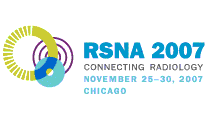
Abstract Archives of the RSNA, 2007
LL-NR4061-L05
Cervicocerebral CT Angiography Using Low Volume and High Concentration of Contrast Material in Patients with Stroke and TIA
Scientific Posters
Presented on November 28, 2007
Presented as part of LL-NR-L: Neuroradiology/Head and Neck
Nobuyuki Takeyama MD, Presenter: Nothing to Disclose
Yoshimitsu Ohgiya MD, Abstract Co-Author: Nothing to Disclose
Yoshimasa Takahashi, Abstract Co-Author: Nothing to Disclose
Masao Obuchi MD, Abstract Co-Author: Nothing to Disclose
Seishi Matsui MD, PhD, Abstract Co-Author: Nothing to Disclose
Takehiko Gokan MD, Abstract Co-Author: Nothing to Disclose
Hidenori Shinjo, Abstract Co-Author: Nothing to Disclose
Yuko Kinebuchi, Abstract Co-Author: Nothing to Disclose
Tadashi Kitahara, Abstract Co-Author: Nothing to Disclose
et al, Abstract Co-Author: Nothing to Disclose
et al, Abstract Co-Author: Nothing to Disclose
Our purpose was to prospectively assess diagnostic performance of cervicocerebral CT angiography (CTA) using 40-mL of 370 mgI/mL contrast material (40-mL CTA), compared with CTA using 60-mL of 300 mgI/mL contrast material (60-mL CTA).
CTA was performed on a 32-MDCT system with 1.25 mm collimation, and 0.625 mm reconstruction interval. Scan coverage ranged between aortic arch (AA) and distal to the circle of Willis (cW). Fifty six patients with ischemic stroke and TIA were divided into two groups: group 1 (n=28) used 60-mL CTA with 25-mL of saline flushing at a flow rate of 4 mL/sec; group 2 (n=28) used 40-mL CTA with same fashion. First, time to peak arterial enhancement at cW (Tc) was calculated, and scan duration (sd) between AA and cW was measured. Next, scan speed was 96.9 mm/sec, and scan delay was individually decided according to Tc and sd. Arterial attenuation mesurements were performed along z-axis at 9 points in carotid-cerebral artery (CCA) and 3 points in vertebrobasilar artery (VBA). Venous attenuation measurements of the internal jugular vein (IJV) at carotid bifurcation were performed. Mean attenuation of those vessels were quantitatively analysed. In addition, post-processing 2D and 3D images were qualitatively assessed.
Arterial enhancement profile along z-axis in CCA showed an increase in the attenuation values at distal common carotid artery in both groups. There were no differences of mean arterial attenuation in CCA between 60-mL CTA (399.4 ± 56.6 HU) and 40-mL CTA (401.1 ± 51.6 HU; p=0.88), and in VBA between 60-mL CTA (377.3 ± 64.3 HU) and 40-mL CTA (389.7 ± 51.7 HU; p=0.45). Arterial images showed no difference qualitatively in both groups. On the other hand, 40-mL CTA (95.9 ± 63.2 HU) showed significant lower venous attenuation than 60-mL CTA (202.3 ± 105.3 HU; p<0.001). Venous contamination of IJV was less prominent in 40-mL CTA.
We conclude that 40-mL CTA can provide sufficient diagnostic performance.
Reducing total amount of iodine is beneficial in patients with pre-existing renal impairment and in patients who must receive additional contrast material for other radiologic examinations.
Takeyama, N,
Ohgiya, Y,
Takahashi, Y,
Obuchi, M,
Matsui, S,
Gokan, T,
Shinjo, H,
Kinebuchi, Y,
Kitahara, T,
et al, ,
et al, ,
Cervicocerebral CT Angiography Using Low Volume and High Concentration of Contrast Material in Patients with Stroke and TIA. Radiological Society of North America 2007 Scientific Assembly and Annual Meeting, November 25 - November 30, 2007 ,Chicago IL.
http://archive.rsna.org/2007/5003909.html

